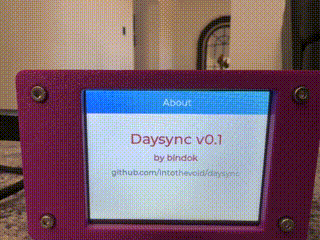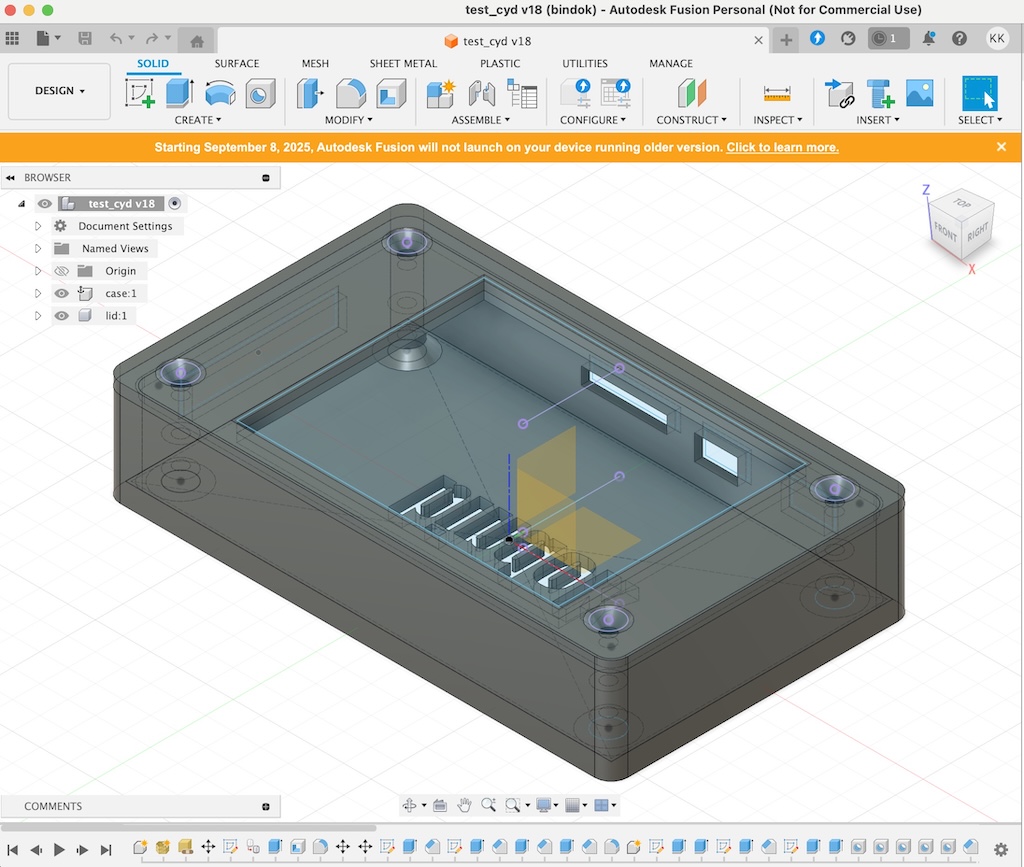Daysync - An ESP32 based smart screen for your desk
A low power smart display for your desk with news, weather, crypto, stocks and other information
Published on Apr 17 2025 at 3:32pm
Overview

Daysync combines an ESP32 microcontroller with a TFT display (ESP32-2432S028R) to create a smart information display system. It fetches and displays various types of data including weather information, MotoGP and Formula 1 race calendars, cryptocurrency prices, stock market data and news headlines.
graph LR
subgraph ESP32["ESP32 Display"]
E[ESP32 Board]
T[TFT Display]
E --> T
end
subgraph Backend["Go Backend"]
B[API Server]
W[Weather API]
M[MotoGP API]
F[F1 API]
C[Crypto API]
N[News API]
S[Stock API]
end
E <-->|HTTP Requests| B
B <-->|Data Fetch| W
B <-->|Data Fetch| M
B <-->|Data Fetch| F
B <-->|Data Fetch| C
B <-->|Data Fetch| N
B <-->|Data Fetch| S
Parts
ESP32-2432S028R with 2.4” TFT Display
These boards are cheap and easy to find on AliExpress. You can find them here.
3D Printed Enclosure
I designed a 3D printed enclosure using the free version of Autodesk Fusion 360 for the ESP32-2432S028R with 2.4” TFT Display. This was quite time consuming and I had to use Vernier Callipers to get accurate measurements. At the end of it, the result was better than I expected. I used a Bambu Labs P1S printer to print the enclosure. I even managed to get a cool bindok logo etched at the back of the enclosure.
bindok meaning no brains is my gamer alias 🤣

You can download the STL file here
Other Parts
- Micro USB Cable for programming the ESP32
- USB power (any cheap 5V adaptor)
- USB-C to micro usb adaptor if your PC only has USB-C ports
- Vernier Callipers for measuring the dimensions of the board
Source Code
The source code is available on GitHub.
System Architecture
The project consists of two main components:
ESP32 Display System
- ESP32 microcontroller
- TFT display
- WiFi connectivity
- LVGL for UI rendering
Go Backend Server
- RESTful API endpoints
- Data caching
- External API integration
- Configuration management
graph TD
subgraph ESP32["ESP32 System"]
W[WiFi Module]
M[Memory]
D[Display Driver]
W --> M
M --> D
end
subgraph Backend["Backend Services"]
C[Cache Layer]
A[API Layer]
E[External APIs]
C --> A
A --> E
end
ESP32 <-->|HTTP| Backend
Backend Functionality
API Endpoints
The Go backend provides several RESTful endpoints:
graph TD
API[API Server] --> MotoGP[MotoGP Endpoints]
API --> F1[F1 Endpoints]
API --> Weather[Weather Endpoint]
API --> Crypto[Crypto Endpoint]
API --> News[News Endpoint]
API --> Finance[Finance Endpoint]
MotoGP --> |/api/motogp| SeasonData
MotoGP --> |/api/motogpnextrace| NextRace
F1 --> |/api/formula1| SeasonData
F1 --> |/api/formula1nextrace| NextRace
Weather --> |/api/weather| LocationData
Crypto --> |/api/crypto| PriceData
News --> |/api/news| Headlines
Finance --> |/api/finance| StockData
Data Flow
sequenceDiagram
participant ESP32
participant Backend
participant ExternalAPI
ESP32->>Backend: HTTP Request
Backend->>Backend: Check Cache
alt Cache Hit
Backend-->>ESP32: Return Cached Data
else Cache Miss
Backend->>ExternalAPI: Fetch New Data
ExternalAPI-->>Backend: Return Data
Backend->>Backend: Update Cache
Backend-->>ESP32: Return Fresh Data
end
ESP32 Display Features
Screen Management
The ESP32 display automatically cycles through different information screens:
stateDiagram-v2
[*] --> Weather
Weather --> MotoGP
MotoGP --> Formula1
Formula1 --> StockMarket
StockMarket --> Cryptocurrency
Cryptocurrency --> News1
News1 --> News2
News2 --> About
About --> Weather
Data Display
Each screen type has specific information layout:
graph TD
subgraph Weather["Weather Screen"]
W1[Location]
W2[Date/Time]
W3[Temperature]
W4[Humidity]
W5[Conditions]
end
subgraph Racing["Race Calendar Screen"]
R1[Race Name]
R2[Circuit]
R3[Date]
R4[Next Race Info]
end
subgraph Finance["Financial Screen"]
F1[Symbol]
F2[Current Price]
F3[Price Change]
F4[Market Data]
end
Technical Implementation
Backend Features
Caching System
- 60-minute cache duration
- Memory-efficient storage
- Automatic cache invalidation
API Integration
- RESTful endpoints
- Error handling
- Rate limiting
- CORS support
Configuration Management
- YAML configuration
- Environment variables
- Test mode support
ESP32 Features
Display Management
- LVGL for UI
- Screen rotation
- Automatic updates (Server side, microcontroller auto updates not supported)
- Error handling
Data Processing
- JSON parsing
- Data validation
- Error recovery
- WiFi reconnection
Development and Testing
The project includes several development features:
graph LR
subgraph Dev["Development Tools"]
T[Test Mode]
C[Cache Control]
D[Debug Logging]
M[Mock Data]
end
subgraph Test["Testing Features"]
U[Unit Tests]
I[Integration Tests]
E[Error Simulation]
P[Performance Tests]
end
Possible Future Enhancements
- Planned Features
- Ability for user to change their wifi SSID and password (harcoded at the moment)
- Custom screen layouts
- User preferences
- More data sources
- Offline mode
- Automatic OTA updates
This was a fun project that taught me how to use a low power microcontroller to display information. The ESP32 only makes REST calls, the heavy lifting is done by the Go backend. By combining the power of ESP32 with a Go backend, it provides a flexible way to display various types of real-time data.
There can be many improvements to enhance the user experience. User preferences via a web interface would be great. I’ll hopefully find time to keep improving this project and make it more user friendly.
Tags: golang , c++ , programming , electronics , iot